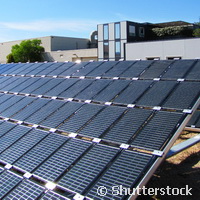Developing a cheaper, alternative solar cell for Europe
With climate change threatening and worldwide CO2 emission levels higher than ever, the need for renewable energy technologies is now critical. But for widespread market acceptance, these new technologies have to be cheap, suitable for mass production and easy to implement. Ultimately, a balance has to be struck, minimising greenhouse emissions while not harming future economic growth and quality of life. The EU-funded project SCALENANO ('Development and scale-up of nanostructured based materials and processes for low-cost high-efficiency chalcogenide-based photovoltaics') aims to produce high-efficiency photovoltaic (PV) cells based on alternatives to standard silicon technologies. A PV cell or solar cell is an electrical device that converts the energy of light directly into electricity. Professor Alejandro Perez-Rodriguez of the Catalonia Institute for Energy Research, SCALENANO's project coordinator, says the researchers are focusing on chemical processes that, in contrast with most industrial technologies, do not require complex and very expensive machinery and equipment. "The development of thin film-based technologies will allow high photovoltaic conversion efficiencies with a significant lowering of fabrication costs," he says. SCALENANO, says Professor Perez-Rodriguez, will apply innovative processes based on the electro-deposition of nanostructured precursors, as well as alternative processes with very high potential throughput and process rates. These include printing techniques with novel nanoparticle ink formulations and new cost-effective deposition techniques. "To achieve our ambitious objectives, we are exploring new cell architecture concepts based on nanostructured zinc oxide layers," he says. "In addition, in order to improve process yield and reliability of the new manufacturing process, techniques are being developed for quality assessment and process monitoring. These are non-destructive techniques that have to be able to provide relevant information, if possible in real time, as we move forward with the fabrication of the solar cells and modules." Eighteen months into the 42-month project, Professor Perez-Rodriguez says some interesting results have already been achieved. The researchers have demonstrated the scalability of electro-deposition-based processes for the synthesis of very homogeneous large areas of thin-film chalcogenide absorbers. They have already produced medium-area solar modules with cell efficiency of up to 15.4 percent. He adds: "Meanwhile, we have also defined scalable routes for the synthesis of nanoparticles to be used in inks for solar-cell precursor fabrication using very fast and simple printing processes, similar to those used to print a newspaper." The researchers have also identified processes, including chemical bath deposition and new electrostatically spray assisted vapour deposition (ESAVD) processes for the synthesis of transparent conductive oxide (TCO) layers, an essential part of the solar cell. SCALENANO's work could be an important step towards increasing the share of renewable energy sources in the EU's energy mix, and help make solar cell manufacturers more competitive. "We are talking about helping to develop a new energy production model, which constitutes a key challenge for the 21st century," says Professor Perez-Rodriguez. "Competitive PV technologies will allow average citizens to become energy producers, paving the way to self-production of electricity. This will definitely contribute to a more decentralised energy model where people play an active role." SCALENANO has received around EUR 7.5 million in EU funding and is scheduled to complete its work in July 2015. The project is an active member of the EU PV Clusters, the European Clusters of projects on nanotechnology and photovoltaics, a unique and important initiative at the European level aimed at bringing together all the projects on photovoltaics to discuss industrial strategies and highlight the leading role of nanotechnology. SCALENANO will host the Second Workshop and General Assembly of the EU PV Clusters (Barcelona, November 2013).For more information, please visit: SCALENANO http://www.scalenano.eu/ Project factsheet EU PV Clusters http://www.eupvclusters.eu Catalonia Institute for Energy Research http://www.irec.cat/
Countries
Spain



